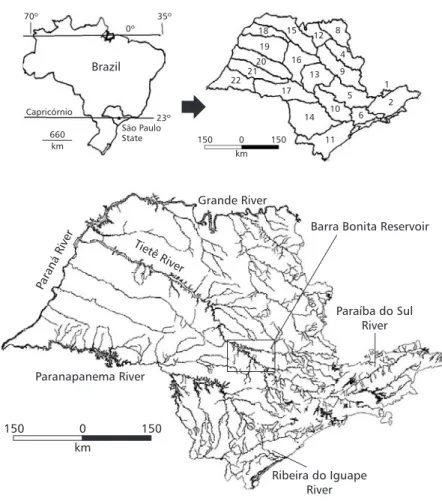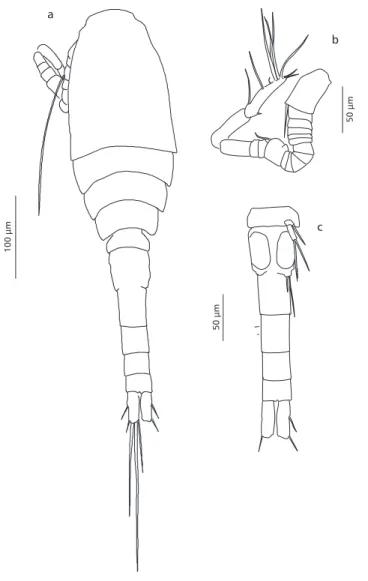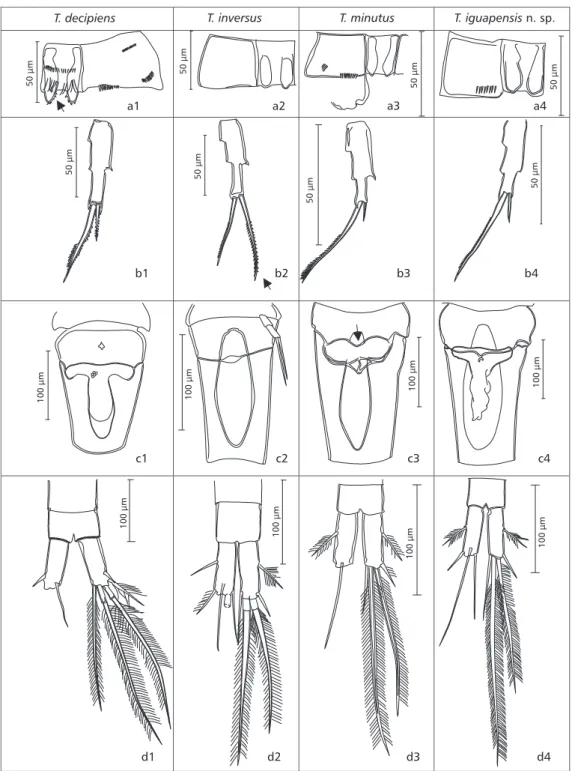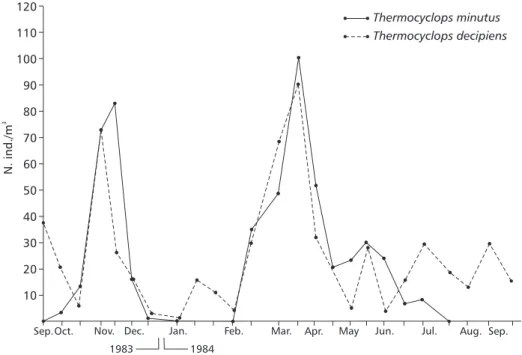Braz. J. Biol., 65(3):521-531, 2005 TAXONOMY, ECOLOGY AND GEOGRAPHICAL DISTRIBUTION OF THE GENUS Thermocyclops 521
TAXONOMY, ECOLOGY, AND GEOGRAPHICAL
DISTRIBUTION OF THE SPECIES OF THE GENUS
Thermocyclops
KIEFER, 1927 (COPEPODA, CYCLOPOIDA)
IN SÃO PAULO STATE, BRAZIL, WITH DESCRIPTION
OF A NEW SPECIES
SILVA, W. M.1 and MATSUMURA-TUNDISI, T.2
1Departamento de Hidráulica e Transporte, Universidade Federal do Mato Grosso do Sul 2International Institute of Ecology, Rua Bento Carlos, 750, CEP 13560-660, São Carlos, SP, Brazil Correspondence to: William Marcos da Silva, Departamento de Hidráulica e Transporte, Universidade Federal do
Mato Grosso do Sul, e-mail: wmsilvax@starmedia.com
Received July 3, 2003 – Accepted December 9, 2003 – Distributed August 31, 2005 (With 6 figures)
ABSTRACT
The taxonomy and ecology of the cyclopoid copepod genus Thermocyclops were studied. Samples were collected in 207 water bodies located in the 22 hydrographic basins of São Paulo State, Bra-zil, including large reservoirs, small and shallow lakes, and ponds and rivers. The genus Thermocyclops
inhabits mainly water bodies within a limnetic region. Four species were found, of which one is new:
Thermocyclops iguapensis, which occurred in the reservoirs of the Ribeira do Iguape and Paraíba do Sul basins. The description of the new species and the geographical distribution of all four species in São Paulo State are presented. Thermocyclops decipiens was the most frequent species, occurring in 71% of the water bodies within a limnetic region. This species is characteristic of eutrophic en-vironments where it can occur in great abundance, whereas Thermocyclops minutus is characteris-tic in oligotrophic systems. Thermocyclops inversus and Thermocyclops iguapensis n. sp. were not common but can occur together with Thermocyclops decipiens.
Key words: taxonomy, ecology, geographical distribution, Thermocyclops iguapensis n. sp. co-occurrence.
RESUMO
Taxonomia, ecologia e distribuição geográfica das espécies do gênero Thermocyclops
Kiefer, 1927 no estado de São Paulo, com a descrição de uma espécie nova
Foram realizadas coletas em 207 corpos de água, distribuídos em 22 unidades de gerenciamento de recursos hídricos (UHGRH) do estado de São Paulo no período de 1999 a 2002, abrangendo grandes e pequenos reservatórios, lagoas marginais e grandes rios. Nestas coletas foram analisadas as espécies do gênero Thermocyclops quanto à taxonomia, distribuição geográfica e freqüência de ocorrência. O gênero Thermocyclops ocorreu em corpos de água com zona limnética bem desenvolvida e com raras exceções em ambientes estritamente litorâneos. Foram registradas quatro espécies, sendo Thermcyclops iguapensis espécie nova, que ocorreu nos reservatórios das UHGRHs Ribeira do Iguape e Paraíba do Sul. A descrição da espécie nova e a distribuição das quatro espécies são apresentadas, mostrando que
Thermocyclops decipiens foi a espécie mais freqüente, ocorrendo em 71% dos corpos de água com região limnética desenvolvida. Esta espécie é característica de ambientes eutróficos, onde ocorre em grande número, e a espécie Thermocyclops minutus é característica de ambientes oligotróficos. Thermocyclops inversus e Thermocyclops iguapensis n. sp. não são espécies freqüentes, mas podem co-ocorrer com a espécie Thermocyclopsdecipiens.
INTRODUCTION
The genus Thermocyclops Kiefer, 1927 (Copepoda, Cyclopoida) originated in the tropical region, in which it presents a high diversity of species (Dumont & Decraemer, 1977). In many tropical water bodies, this genus represents the most important component of the zooplankton biomass (Margalef, 1983). Despite the presence of the genus in South America, high diversity has not been recorded in this continent, as compared to the African and Asian continents (Rocha et al., 1995). In the Western Hemisphere, nine species and subspecies have been recorded (Reid, 1989), four of them occurring in Brazil (Rocha & Botelho, 1998).
Until 1998, three species of Thermocyclops
had been recorded in the freshwater systems of São Paulo State (Rocha & Botelho, 1998; Matsumura-Tundisi & Silva, 1999). Thermocyclops decipiens
(Kiefer, 1929) was the most frequent species, found in several reservoirs and ponds, followed by T. minutus. Thermocyclops inversus Kiefer, 1936, a rare species, was registered in one reservoir located in São Paulo, SP (Rocha & Botelho, op. cit.).
The aim of this work was to evaluate the occurrence of the species of the genus
Thermocyclops in the water bodies of São Paulo State, located in 22 basins that are under hydrographic management and which are referred to as hydrographic management units (HMU).
MATERIAL AND METHODS
Fig. 1 includes two maps of São Paulo State showing its 22 hydrographic basins as well as the hydrographic network with the main rivers where several reservoirs have been constructed in cascade to generate hydroelectricity.
Samplings were carried out during the period of 1999-2002. For each UHGRH, a minimum of 3 and maximum of 29 water bodies were sampled, including the limnetic and littoral regions of large and small reservoirs, as well as ponds and rivers. Geographical coordinates were determined at each site using a Garmin III GPS.
Zooplankton was collected by making vertical and horizontal hauls using a standard plankton net of mesh size 68µm. The samples were preserved in 4% formaldehyde and deposited in the Plankton Museum of the International Institute of Ecology. Species
identifications were performed using only adult females. Drawings and measurements were made using an optical microscope with image acquiring system and drawing software (TurboCAD Version 6.5).
Samples obtained from Barra Bonita Reservoir during the period of September 1983 to October 1984 at fortnightly intervals, were analyzed to study the seasonal fluctuations of two species of Thermocyclops.
RESULTS
Taxonomical studies
Thermocyclops iguapensis n. sp.
Types collected in Brazil, São Paulo State, Ibiuna County, Fumaça Reservoir (24o00’16”S and
47o15’40”W), collected by William M. Silva on
9/19/2001. All types were deposited in the USP museum.
Holotype :: Body size: 720 µm, specimen dissected and mounted on 1 slide (MZUSP: 16196). Allotype ;: Body size: 589 µm, specimen dissected and mounted on 1 slide (MZUSP: 16197). Paratypes: 20 : (average size: 735 µm ± 21) and 10 ; (average size: 585 µm ± 9), not dissected preserved in alcohol 70%, MZUSP 16198 and 16199 respectively.
Description of the female
Figs. 2 shows the general aspect of the female (Fig. 2a) and her appendages. Antennule (Fig. 2b): 17 segments, extending past 3rd thoracic segment,
17th segment without hyaline membrane. Antenna
(Fig. 2c):1st segment with few rows of spinules and
one seta on caudal side; 4th segment with hyaline
Braz. J. Biol., 65(3):521-531, 2005 TAXONOMY, ECOLOGY AND GEOGRAPHICAL DISTRIBUTION OF THE GENUS Thermocyclops 523
Description of the male
Fig. 3a shows the general aspect of the male. Antenna (Fig. 3b): 17 segments with geniculation in the 9th and 15th segments. Leg 5 (Fig. 3c): internal
apical spine passing leg 6 insertion.
Etymology: A reference to the Ribeira do Iguape Hydrographic Basin where this species was found in high abundance.
Differential diagnosis: Thermocyclops iguapensis n. sp. differs from other American
Thermocyclops species by a combination of characteristics such as intercoxal sclerite of legs 1-4 without spinular ornamentations on distal margins;
ratio between the terminal spines of endopodite 3 of leg 4; and principally, the difference in the morphology of the receptaculum seminis.
Remarks: T. iguapensis n. sp. was recorded in the reservoirs of the Ribeira do Iguape Basin and in reservoirs of the Paraíba do Sul hydrographic basins by Sendacz & Kubo (1982) but was identified as T. minutus.
The figures (51 to 56) presented by the authors show characteristics similar to those presented by
T. iguapensis n. sp. and differing from the characteristics of T. minutus, especially in the morphology of the receptaculum seminis.
Barra Bonita Reservoir 660
km 150 150
0º
70º 35º
23º São Paulo State Capricórnio
Brazil
0 km
1
2 18
4
5
6 19
8
9
10
11 12
13
14 15
16
17 20 21 22
Grande River
Tietê River
Paraná River
Paranapanema River
Paraíba do Sul River
Ribeira do Iguape River
150 0 150
km
a
b
100
m
µ
50 mµ
50 mµ c
d
e
50 mµ
f 50 mµ
50 mµ
h i
j k
50
m
µ
100
m
µ
n
50
m
µ
50
m
µ
50
m
µ
50
m
µ
50
m
µ 50
m
µ
g
l
m
Braz. J. Biol., 65(3):521-531, 2005 TAXONOMY, ECOLOGY AND GEOGRAPHICAL DISTRIBUTION OF THE GENUS Thermocyclops 525
100
m
µ
50
m
µ
50
m
µ
a
b
c
Fig. 3 — Male of Thermocyclops iguapensis n.sp.: a) general aspect; b) antennule; c) last thoracic segment and abdominal segments.
Differential diagnosis and key for São Paulo
Thermocyclops species
Fig. 4 shows the main differences presented by the four species of Thermocyclops found in São Paulo State: T. decipiens, T. inversus, T. minutus
and T. iguapensis n. sp.
Thermocyclops decipiens: average size of 10 adult females: 823 µm ± 21. Leg 4: intercoxal sclerite with ornamental spines in prominences on distal margins (Fig. 4-a1) and 3rd endopodite with outer
apical spine 2.4 times as long as the inner (Fig. 4-b1). Receptaculum seminis (Fig. 4-c1): lateral arms slightly curved in the proximal and distal parts. Caudal rami (Fig. 4-d1): 2.28 times longer than wide,
lateral setae nearly on the distal margin, and internal setae 3 times longer than the external.
Thermocyclops inversus: average size of 10 adult females: 637 µm ± 17. Leg. 4: intercoxal sclerite without ornamental spines in prominences on distal margins (Fig. 4-a2), and 3rd endopodite
with outer apical spine 0.8 time as long as the inner (Fig. 4-b2). Receptaculum seminis: lateral arms narrow (Fig. 4-c2). Caudal rami: 3.2 times as long as wide, lateral setae on the middle of the caudal rami, internal setae 2.16 times long than the external (Fig. 4-d2).
intercoxalsclerite without ornamental spines in prominences on distal margins, and 3rd endopodite
with outer apical spine 5 times longer than the inner (Fig. 4-b3). Receptaculum seminis (Fig. 4-c3): lateral arms slightly curved in the proximal part of ante-rior margin, pore canal curveted and posteante-rior margin located above the lateral arms. Caudal rami (Fig. 4-d3): 2.4 times longer than wide, lateral spine on the middle of the caudal rami, internal setae 1.8 time longer than the external.
Thermocyclops iguapensis n. sp.: 4th leg (Fig.
4-a4): intercoxal sclerite without ornamental spines in prominences on distal margins, 3rd endopodite
with outer apical spine 3.5 times longer than the inner (Fig. 4-b4). Receptaculum seminis (Fig. 4-c4): lateral arms slightly curved on the distal margin, pore canal short, and posterior margin located in the middle of the lateral arms. Caudal rami (Fig. 4-d4): 3.1 times as long as wide, lateral spine on the middle of the caudal rami, internal setae 2.6 times longer than the external.
Identification key for Thermocyclops species found in the hydrographic basins of São Paulo State
1. Sclerite intercoxal of leg 4 with spine or-namentation on the distal margin (Fig. 4-a1)...2 Sclerite intercoxal of leg 4 without spine ornamentation on the distal margin (Fig. 4-a2 and a4)...3 2. 3rd endopodite of leg 4 with outer apical
spine 2.4 times as long as inner (4-b1)...T. decipiens
3. 3rd endopodite of leg 4 with apical outer
spine longer than inner (Fig. 4-b2)...T. inversus
3rd endopodite of leg 4 with apical outer
spine shorter than inner spine...4 4. 3rd endopodite of leg 4 with outer apical
spine 5 times longer than the inner (Fig. 4-b3) and receptaculum seminis with an-terior margin showing a depression in the proximal part (Fig. 4-c3)...T. minutus
3rd endopodite of leg 4 with outer apical
spine 3.5 times longer than the inner (Fig. 4-b4)...5
5. Receptaculum seminis with anterior margin having no depression in the proximal part (Fig. 4-c4)...T. iguapensis n. sp.
Geographical distribution and frequency of occurrence of Thermocyclops species of São Paulo State
Among the Cyclopoida, the genus Thermo-cyclops is characteristic of the limnetic region of lakes.
Table 1 shows the number of water bodies studied in the 22 hydrographic basins of São Paulo State, the number of water bodies that present a limnetic zone, and the frequency of occurrence of the four species in each hydrographic basin.
Thermocyclops decipiens was the most frequent species, having been found in 71% of the water bodies with a limnetic region, and occurring in all the hydrographic basins with the exception of the Mantiqueira. Thermocyclops minutus was found in 25% of the water bodies with a limnetic region. This species occurred in a large number of the water bodies considered oligotrophic. Itwas distributed in the three largest river basins: Tietê, Parapanema, and Rio Grande, but was not found in the Mantiqueira, Litoral Norte, Baixada Santista, and Ribeira do Iguape basins.
Thermocyclops inversus and the new species,
Thermocyclops iguapensis,were rare, the former occurring in 8% and the latter in 6% of the limnetic samplings. Both species occurred in several reservoirs of the Ribeira do Iguape Basin.
Thermocyclops inversus was recorded also in water bodies from the Pardo, Alto Tietê, Mogi, Tietê/ Jacaré, Turvo Grande, and São José dos Dourados basins. Thermocyclops iguapensis was recorded only in the Ribeira do Iguape and Paraíba do Sul basins, so that its distribution was restricted to the hydrographic basins, which are coastal basins, located n. sp. in the east of São Paulo State where the rivers flow to the Atlantic Ocean.
Fig. 5 shows the distribution maps of
Thermocyclops decipiens, Thermocyclops inversus,
Braz. J. Biol.,
65
(3
):
521-531, 2005
TAXONOMY
, ECOLOGY AND GEOGRAPHICAL DISTRIBUTION OF THE GENUS
Thermocyclops
527
Hydrographic basins
Number of water bodies sampled
Number of water bodies with limnetic
zone
Thermocyclops decipiens
Thermocyclops mintus
Thermocyclops inversus
Thermocyclops iguapensis n. sp.
Mantiqueira (1) 19 3 – – – –
Paraíba do Sul (2) 8 5 5 0 0 2
Litoral Norte (3) 11 3 1 0 0 0
Pardo (4) 5 4 3 0 2 0
Piracicaba/Capivari/Jundiaí (5) 6 6 3 0 0 0
Alto-Tietê (6) 16 12 9 3 1 0
Baixada Santista (7) 7 4 2 0 0 0
Sapucaí-Mirim/Grande (8) 4 3 2 3 0 0
Mogi-Guaçu (9) 29 19 16 2 1 0
Sorocaba-Médio-Tietê (10) 3 3 1 1 0 0
Ribeira do Iguape e Lit. Sul (11) 11 11 11 0 5 6
Baixo Pardo/Grande (12) 7 5 3 2 0 0
Tietê/Jacaré (13) 21 15 7 4 1 0
Paranapanema (14, 17 and 22 ) 7 7 7 6 0 0
Turvo/Grande (15) 13 12 8 0 1 0
Tietê/Batalha (16) 8 3 2 2 0 0
São José dos Dourados (18) 5 3 1 2 1 0
Baixo Tietê (19) 8 3 4 3 0 0
Aguapeí (20) 12 5 5 4 0 0
Peixe (21) 7 5 4 1 0 0
Total 207 131 94 33 12 8
Frequency of occurrence – 131 71% 25% 9% 6%
TABLE 1
T. decipiens T. inversus T. minutus T. iguapensisn. sp.
50
m
µ
50
m
µ
50
m
µ
50
m
µ
50
m
µ
50
m
µ
50
m
µ
50
m
µ
100
m
µ
100
m
µ
100
m
µ
100
m
µ
100
m
µ
100
m
µ
100
m
µ
100
m
µ
a1 a2 a3 a4
c1
b2 b3 b4
b1
c2 c3 c4
d1 d2 d3 d4
Braz. J. Biol., 65(3):521-531, 2005 TAXONOMY, ECOLOGY AND GEOGRAPHICAL DISTRIBUTION OF THE GENUS Thermocyclops 529
Thermocyclops
decipiens Thermocyclops minutus
Thermocyclops iguapensisn. sp.
Thermocyclops inversus
10 20 30 40 50 60 70 80 90 100 110 120
N.
ind./m
3
Sep.Oct. Nov. Dec. Jan. Feb. Mar. Apr. May Jun. Jul. Aug. Sep.
1983 1984
Thermocyclops minutus Thermocyclops decipiens
Fig. 5 — Distributions of Thermocyclops species in São Paulo State. a) Thermocyclops decipiens, b) Thermocyclops minutus, c) Thermocyclops iguapensis n. sp., d) Thermocyclops inversus.
Seasonal fluctuation of Thermocyclops
populations in Barra Bonita Reservoir
Barra Bonita Reservoir is the first of six reservoirs constructed in cascade in the Middle Tietê River Basin (Fig. 1). The reservoir receives from the Tietê River all the domestic and industrial sewage produced in the metropolitan area of São Paulo, SP, as well as pollution from the Piracicaba River, another tributary. The reservoir presents eutrophic characteristics with high concentrations of phosphorus, nitrogen, and chlorophyll, and frequent presence of cyanobacterial blooms. The abundances in this reservoir of two species of Thermocyclops,
T. deciepiens,and T. minutus,from September 1983 to September 1984, were analyzed at a time when the reservoir was meso-eutrophic. Both populations showed high abundances during the same periods (November-December and March-April). However, while Thermocyclops minutus disappeared comple-tely in some periods (the end of July to October),
Thermocylops decipiens occurred throughout the period (Fig. 6).
DISCUSSION
Thermocyclops iguapensis n.sp. was found only in two basins of São Paulo State: the Ribei-ra do Iguape and PaRibei-raíba do Sul. Sendacz & Kubo (1982) found it in the water bodies of those basins, but identified the species as Thermocyclops minutus. T. iguapensis n. sp. as well as T. inversus have narrow geographical distributions, being restricted to the hydrographic basins in the eastern part of São Paulo State.
The most frequent species, Thermocyclops decipiens, has wide geographical distribution occurring in many types of water bodies in all of the hydrographic basins, whereas Thermocyclops minutus is less widely distributed, thus indicating more restrictive ecological requirements. The occurrence of these two species in Barra Bonita Reservoir (which this time was meso-eutrophic) with similar abundances in some periods of the year and complete disappearance of Thermocyclops minutus
in other periods (mainly in the winter and spring) indicates that the two species probably present some different ecological requirements. Much evidence shows that Thermocyclops minutus is common in
oligotrophic and mesotrophic environments (Matsumura-Tundisi & Tundisi, 1976; Tundisi et al., 1997). Silva & Matsumura-Tundisi (2002) recorded clear patterns of dominance of
Thermocyclops minutus over Thermocyclops decipiens in oligo-mesotrophic reservoirs and dominance of T. decipiens over T. minutus in eutrophic reservoirs.
The co-occurrence of Thermocyclops inversus
and Thermocyclops decipiens in some eutrophic water bodies of the Ribeira do Iguape Basin (Iporanga and Jurupará reservoirs) showed that
Thermocyclops inversus outnumbered Thermo-cyclops decipiens (Table 1). Thus, the former species probably has better adaptive strategies than does
Thermocyclops decipiens in eutrophic systems.
Acknowledgements — This work is part of BIOTA/FAPESP-Virtual Institute of Biodiversity. The authors express their thanks to Dr. Kennedy F. Roche for an English revision and FAPESP for financial support (Thematic Project:98/5091-2 and fellowship process: 99/05104-0).
REFERENCES
DUMONT, H. J. & DECRAEMER, W., 1977, On the continental Copepod fauna of Morocco. Hydrobiologia, 52(2-3): 257-278.
MARGALEF, R., 1983, Limnología. Ediciones Omega, Barcelona.
MATSUMURA-TUNDISI, T. & TUNDISI, J. G., 1976, Plankton studies in a lacustrine environment. Oecologia (Berl.), 25: 265-270.
MATSUMURA-TUNDISI, T. & SILVA, W. M., 1999, Crustáceos Copépodos planctônicos. In: C. A. Joly & C. E. M. Bicudo (orgs.), Biodiversidade do Estado de São Paulo, Brasil. 4.
Invertebrados de Água Doce. FAPESP, São Paulo, pp. 91-100.
REID, J. W., 1989, The distribution of species of the genus
Thermocyclops (Copepoda Cyclopoida) in the Western Hemisphere, with description of T. parvus, new species.
Hydrobyologia,175: 149-174.
ROCHA, C. E. F. & BOTELHO, M. J. C., 1998, Maxillopda-Copepoda. Cyclopoida. In: P. S. Young (ed.), Catalogue of Crustacea of Brazil. Museu Nacional, Rio de Janeiro, pp. 129-166 (Série Livros N.6).
Braz. J. Biol., 65(3):521-531, 2005 TAXONOMY, ECOLOGY AND GEOGRAPHICAL DISTRIBUTION OF THE GENUS Thermocyclops 531
SENDACZ, S. & KUBO, E., 1982, Copepoda (Calanoida e Cyclopoida) de reservatórios do Estado de São Paulo. Boletim do Instituto de Pesca 9 (único), pp. 51-189.
SILVA, W. M. & MATSUMURA-TUNDISI, T., 2002, Distribution and abundance of Cyclopoida populations in a cascade of reservoirs of the Tietê River (São Paulo State, Brazil). Verh. Internat. Verein. Limnol.,28: 667-670.
TUNDISI, J. G., MATSUMURA-TUNDISI, T., FUKUARA, H., MITAMURA, T., ROCHA, O., GULLEN, S. M., HENRY, R., CALIJURI, M. C., IBANEZ, M. S. R., ESPÍNDOLA, E. L. G. & GOVONI, S., 1997, Limnology of fifteen lakes.




